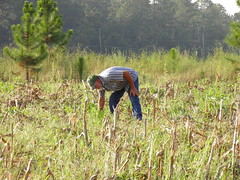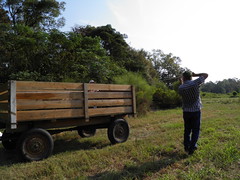Pictures by John S. Quarterman, Lowndes County, Georgia, 19 Feb 2011.
-jsq
Continue readingCommentary
A Call for Skepticism
by Steven K. Roberts
Camano IslandIf ever we needed a demonstration that the fundamental flaw in many arguments is a lack of discrimination regarding information sources, we have it in the Nels Konnerup article, “Toxicology 101 Defended,” in the March 26 issue of the S/C News.
The author makes a “plea for cogent thought, rather than a visceral reaction to the use of pesticides and herbicides,” and cites a number of references “authored by highly qualified and respected scientists.” So far, so good.
But just for fun, I spent a few minutes researching some of these sources to see if I could determine the affiliations and biases of their authors.
Further, William Bartram did mention it in his Travels of 1791, as
French mulberry.
Curiously, even though Google books does have Bartram’s book,
ngrams doesn’t seem to show French mulberry for that date,
but does show American mulberry.
Even more curious, William Bartram’s father, John Bartram,
corresponded with Linnaeus, the founder of modern
botanical terminology.
The currently most popular name is beautyberry, which turns out to be related to the scientific genus name, Callicarpa: Greek kalli means beautiful, and Karpos means fruit.
The plant has all sorts of uses: Continue reading
Anyway, comparing the common name beautyberry to the scientific name Callicarpa americana, it seems that the “common” name is much newer, at least in books.
Beautyberry is a piney woods bush that fruits as small violet berries that make tasty jars of jelly:


-jsq
 Tom Philpott asks in Grist about
Why Monsanto is paying farmers to spray its rivals’ herbicides
Tom Philpott asks in Grist about
Why Monsanto is paying farmers to spray its rivals’ herbicides
…Monsanto has been forced into the unenviable position of having to pay farmers to spray the herbicides of rival companies.Roundup, trade name for glysophate, doesn’t work anymore because the weeds mutated: Continue readingIf you tend large plantings of Monsanto’s “Roundup Ready” soy or cotton, genetically engineered to withstand application of the company’s Roundup herbicide (which will kill the weeds — supposedly — but not the crops), Monsanto will cut you a $6 check for every acre on which you apply at least two other herbicides. One imagines farmers counting their cash as literally millions of acres across the South and Midwest get doused with Monsanto-subsidized poison cocktails.
The move is the latest step in the abject reversal of Monsanto’s longtime claim: that Roundup Ready technology solved the age-old problem of weeds in an ecologically benign way.
More pictures in the flickr set.
Pictures by Gretchen Quarterman, Lowndes County, Georgia, 30 Sep 2010.
-jsq
 Who’s that in the field?
Why it’s that Terry Davis,
collecting corn ears that his combine missed!
Who’s that in the field?
Why it’s that Terry Davis,
collecting corn ears that his combine missed!
 Some assembly required for the trailer.
Some assembly required for the trailer.
 Here’s what we want to pick: ears of corn on standing stalks.
Here’s what we want to pick: ears of corn on standing stalks.
Here we go: Continue reading